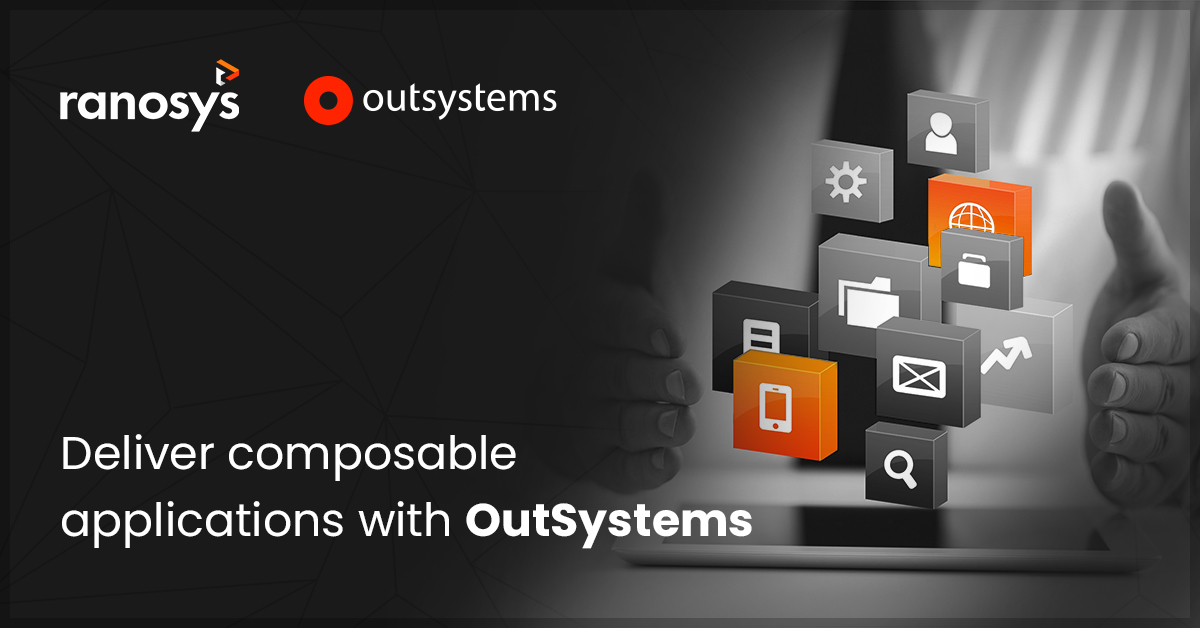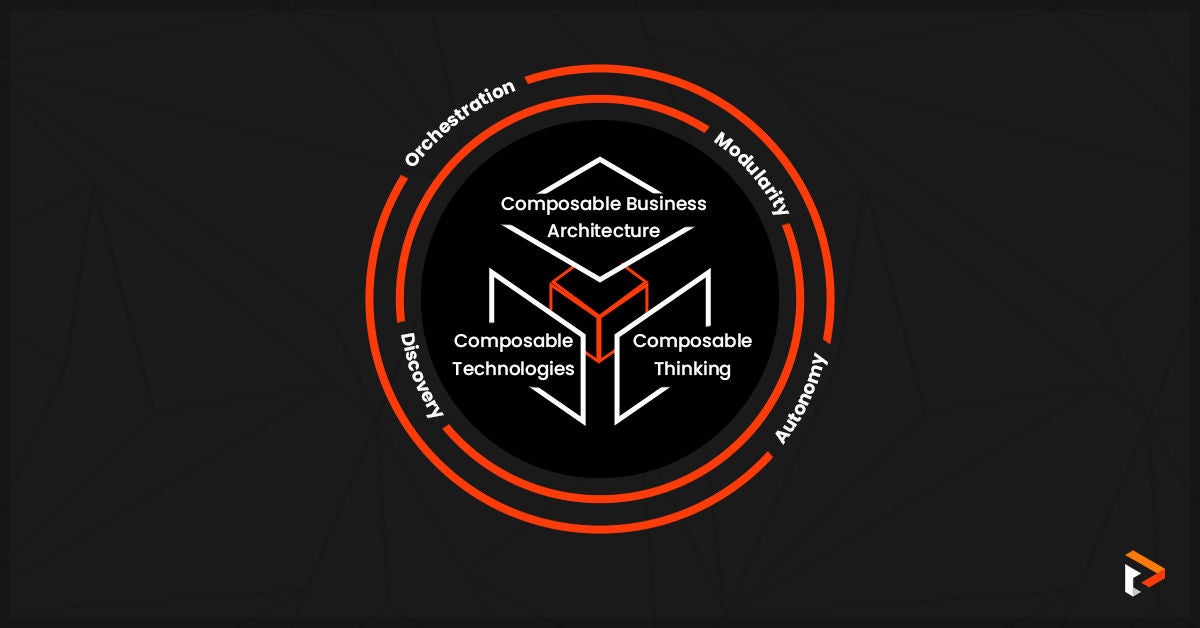How to transform your business into a composable enterprise?
When it comes to choosing the right technology, low-code platforms like OutSystems support composable applications with the appropriate architecture, components, agility, advanced UI/UX, and security. Here we will talk about the Packaged Business Capabilities OutSystems offers that transform your business into a composable enterprise:
- End-user services: Provides screens, UI blocks, and capabilities to deliver end-user interfaces.
- Core services: Summarizes the business logic to complete the processes.
- Foundation services: Contains reusable UI patterns, APIs, plugins capabilities to handle integrations.
- Integration services: Handles external events that need to trigger with some PBC functions.
Key capabilities of OutSystems that support composable apps
Composable business architecture intends to delegate the authority and ownership of the PBCs to smaller teams and gain agility. The OutSystems platform provides composability, reusability, communication, and collaboration. Let’s discuss the key capabilities of OutSystems supporting composable applications:
#1. Rapid Application Development
With the fundamental shift in customer expectations, business agility is referred to as one of the leading digital transformation attributes. Therefore, rapid application development is the idea that benefits building composable applications. OutSystems enables rapid app development via dynamic scaling, automation, performance monitoring, user management, version control, and more. Let’s discuss the following features that help in delivering applications with speed:
- OutSystems allows businesses to create applications using a visual drag-and-drop approach and has many pre-built components that cover unique business requirements. It allows you to easily make customer-facing applications with rapid development.
- OutSystems automates connections to back-end services such as data structures and storage, allowing developers to do more productive work building enterprise-grade applications.
- With OutSystems, you can create core experience components like payment gateways, bookings, add to cart, etc., using a single platform and technology and deploy them across multiple channels.
#2. Increased collaboration between business and IT
Visual-model-driven development is at the core of the OutSystems platform to provide fast, right, and future applications reducing costs and risks by enabling continuous development across all platforms. Visual solutions simplify business process complexities of traditional app development, increasing collaboration across departments.
- OutSystems Workflow Builder can visually map complex business processes and automatically build high-performance, workflow-based apps.
- OutSystems Experience Builder allows rapid prototyping of user-friendly mobile applications that leverage common patterns and flows.
- OutSystems lets you develop with a visual module while retaining complete flexibility to integrate custom code, enabling extensibility, efficiency, and accelerated development.
- The visual-driven approach requires no runtime interpreters or engines are required to enable OutSystems applications. The platform generates applications with a standard architecture.
- The visual application models designed with OutSystems are compiled into standard, well- architectured, and optimized code like JavaScript, HTML, CSS, C#, and Standard SQL.
#3. Innovative architecture
OutSystems modular architecture, you can create applications that enable organizations with pre-built modules that can be deployed, combined, and reused as needed in order to quickly build new solutions. These multi-module solutions eliminate developer or development lifecycle conflicts. Some of the key features that innovate app development are:
- With the modular architecture of OutSystems, multiple developers can work in separate modules with the confidence that their work will not affect others.
- All the versions of applications and modules are stored and can be reused like pre-built modules composed for business users.
- The OutSystems Forge is the largest marketplace of reusable, open-code modules, connectors, UI components, and business solutions. More than 5000+ pre-built templates have helped speed up application delivery time.
- OutSystems architect a modern, automated, and interconnected internal application ecosystem all to overcome legacy application shortcomings and drive greater efficiency.
#4. Reusable components
Reusable components make app development easier and faster with a modular approach. You can deploy core experiences in minutes using pre-built themes, plugins, templates, and components. Let’s look at some capabilities of OutSystems that ensure building reliable applications at scale:
- OutSystems provides you with reusable components in the development environment to enhance the application-building process and deliver scalable and smooth-functioning apps.
- With the OutSystems code reusability feature, you can create applications with lightning speed by reusing code blocks previously developed. It is a cost-effective solution for businesses.
- Multiexpereince development of OutSystems, you can develop an application that can run on any device or platform, reducing risks, development time, and costs with error-free and automated deployments.
- Open platforms in OutSystems protect your investment in large backend systems by integrating with existing systems of record or data sources saving time and money on QA efforts providing error-free applications.
- With automated dependency management and holistic Application Lifecycle Management(ALM), OutSystems low-code capabilities reduce the cost of application maintenance.
#5. Microservices architecture
Earlier organizations were bound to use monoliths and legacy systems and complete task-to-task, which was not meaningful. OutSystems empowers businesses to deliver excellent products with the help of Microservices. Microservices is a software architecture where the application's functionality is broken into smaller fragments to make it more resilient and scalable. Some of the Microservices capabilities that helped in building composable apps are:
- OutSystems provides built-in capabilities that handle security, debugging, troubleshooting, monitoring, and logging.
- With Microservices, you can combine multilingual and develop frameworks and data storage technologies.
- Microservices reinforce the modular structure, which is particularly important for large organizations as it mirrors the communication structure of the organizations that built it.
#6. Enhanced security
The demand for the security of applications is rising as cyberattacks are increasing. OutSystems helps you innovate and accelerate app development, providing a secure runtime environment and tools necessary for fast development. Let’s understand the features of the low-code OutSystems platform:
- Composable applications built using OutSystems are protected by default from the top security threats identified by OWASP.
- OutSystems AppShield provides you with pre-built components that simplify security-related activities such as encrypting data at rest or integrating with Identity Management Systems.
- The state-of-the-art security encompasses a dedicated virtual private cloud (VPC), secure access to on-premises systems with VPN, and easy uploading of SSL/TLS.
- OutSystems maintain a powerful set of operating procedures, including formal hiring procedures for employees, access management, patching management, change management, event management, and incident handling.
Leverage OutSystems capabilities for composable applications with Ranosys
OutSystems low-code platform is perfect for enterprises that want to become composable. It can help you build robust, easy-to-integrate applications without disrupting business processes. But more importantly, OutSystems enhances the UI/UX, compliance, and security. As an OutSystems partner, we have assisted several enterprises in building composable applications, and we can accomplish your business cases too. Connect with our certified experts to know how OutSystems can transform your business composability.







